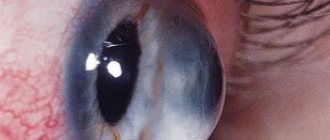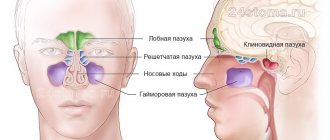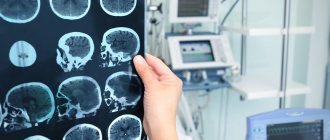Diplopia is doubling of the image. Typically, this condition is called double vision. Diplopia is not a disease, but a symptom, and identifying and treating its cause will help you restore normal vision.
- What is diplopia?
- Causes and complications of diplopia
- Diagnosis and treatment of diplopia
1.Why do I see double?
Double vision is a symptom that needs to be treated very carefully. Some causes of double vision may be relatively minor, but others require urgent medical attention. Let's try to figure out why it can cause double vision and what to do about it.
Why do I see double?
When you open your eyes and see a clear image of the object you are looking at, this is normal. But this seemingly simple and automatic process depends on the coordinated work of several areas of the vision system.
- The cornea
is the “window” of the eyes. The cornea helps focus the light entering the eyes. - The lens behind the pupil
also helps focus light on the retina. - The muscles
of the eyeball allow the eye to turn and look to the sides. - Nerves
are responsible for transmitting visual information from the eyes to the brain. - The brain
processes information received from the eyes.
When you see double, the cause may be problems with any element of this system.
A must read! Help with treatment and hospitalization!
Symptoms
The main sign of concomitant strabismus is a disturbance in the appearance of the eyes when fixating a stationary object in the form of a deviation to one side. The squinting eye can be directed up, down, towards the bridge of the nose or temple.
The features of the concomitant variant of strabismus are the preservation of the full range of mobility of the eyeballs, as well as the equivalence of the angle of deviation of both eyes in the alternating variant of strabismus.
Children with this type of pathology will not have complaints of double vision - despite the lack of binocular vision, there is no diplopia in patients with concomitant strabismus.
Most often, the child complains of decreased visual acuity - at an early age, parents may notice symptoms of concomitant strabismus, such as difficulty fixing their gaze, squinting, and tension when looking at objects at near or far distances.
2. Possible causes of this problem
When you see double, the cause may be problems with any element of this system.
Cornea problems
Problems with the cornea often cause double vision in only one eye. If you close it, you won't see double. Damage to the cornea distorts the incoming light and this becomes the main cause of diplopia. Infection can cause damage to the cornea (for example, shingles can cause distortion of the cornea). Scars on the cornea or dry cornea are other possible causes of double vision.
Problem with the lens of the eye
Cataracts are one of the most common lens problems that cause double vision. If there are cataracts in both eyes, perception will be impaired in each of them. Cataracts can usually be cured with simple surgery.
Eye muscle problems
If the muscles in one eye are weakened, that eye cannot move as smoothly as the healthy eye. And looking in a direction controlled by weak muscles causes double vision. Weakness of the eye muscles may be associated, for example, with myasthenia gravis, an autoimmune disease that blocks the muscles from stimulating the nerves inside the head. Early signs of myasthenia gravis are double vision and drooping eyelids. Graves' disease is another possible cause of eye muscle weakness. Graves' disease usually causes vertical diplopia, where double vision causes one image to be higher than the other.
Nerve problems
The causes of damage to the nerves that control the eye muscles vary. Multiple sclerosis can damage nerves anywhere in the brain or spinal cord. This means you will see double. Diabetes can affect the nerves connected to the muscles that move the eyeball. And this will also lead to diplopia.
Brain problems
The nerves from the eyes are directly connected to the brain. In addition, the entire process of processing visual information from the eyes also occurs in the brain. Therefore, there can be quite a few causes of double vision - stroke, aneurysm, increased pressure in the brain due to injury, bleeding or infection, as well as brain tumors, headaches and migraines.
What else could it be?
Double vision may begin on its own, without other symptoms. But depending on the causes, other symptoms may be present simultaneously with double vision:
- Strabismus;
- Pain when moving the eyes in one or both eyes;
- Pain around the eyes, for example in the eyebrow area;
- Headache;
- Nausea;
- Weakness in the eye muscles and general weakness;
- Drooping eyelids.
Visit our Neurology page
Will tear substitutes help eliminate dry eyes and diplopia?
The key treatment for dry eye syndrome is eye drops that mimic tears. They have a composition close to native tears and help compensate for the lack of hydration. But drops are not a panacea for dry eyes and diplopia, but only a temporary solution to the problem.
None of the existing tear substitutes can eliminate the true causes of dry eyes. The drops do not in any way affect the functioning of the lacrimal apparatus, so they can only temporarily eliminate the unpleasant symptoms of dry eye syndrome, but not the causes of the disease.
In addition, the use of such drugs can lead to its progression. The fact is that frequent instillation of drops helps to wash out important components of tears from the conjunctival cavity. Therefore, their composition changes, the tear film becomes unstable and dries quickly. Because of this, dry eye disease begins to progress, which threatens corneal perforation.
Some drugs can even be dangerous to eye tissue. We are talking about drops with preservatives, which extend the shelf life of the drops, but cause the destruction of goblet cells (they produce an important component of tears - mucin). Therefore, when using tear substitutes with preservatives, there is a risk of rapid progression of dry eye syndrome and the development of diplopia.
3.Diagnostics of double vision
If for some unknown reason you begin to see double, you should immediately consult a doctor. With so many potentially serious causes of double vision, you need to find the cause as soon as possible.
Your doctor will likely use a variety of techniques to determine the cause of double vision. Blood tests, a physical examination, and possibly imaging tests such as a CT scan or MRI are the most commonly used.
General information is very important for diagnosing double vision. Here are some questions your doctor might ask:
- When did the double vision start?
- Have you hit your head, fallen, or been unconscious?
- Have you ever been in an accident?
- Does double vision get worse towards the end of the day or when you are tired?
- Do you have any other symptoms besides double vision?
- Do you have a habit of tilting your head to the side when you look somewhere?
Now focus your vision on some stationary object in your field of vision, for example, a window or a tree behind it.
- Are the two objects that appear as a result of double vision near each other? Or is one higher than the other? Or maybe they are located slightly diagonally? Are any of them larger or smaller?
- Are both images clear? Or is one clear and the other blurry?
- Close one eye and then open it and close the other. Does double vision go away when you look with one eye?
- Imagine that you are looking at a watch dial. Move your eyes in a circle, according to the numbers. Does double vision get worse at certain clock positions? Or is it getting better in some area?
- Tilt your head to the right and then to the left. Does double vision get worse/better in any of these positions?
About our clinic Chistye Prudy metro station Medintercom page!
Diagnostics
It is important for parents to understand that the child must be taken for a preventive examination to an ophthalmologist at 6 months, then regularly repeat visits for early detection of pathologies of the visual system and symptoms of concomitant strabismus. Automatic refractometers and other systems for assessing visual functions in children make it possible to reliably determine the degree of visual impairment and think through further treatment tactics.
During the examination, stereoscopy is determined - binocular vision, since this parameter affects the degree of complexity of pathology correction. Diagnostics involves assessing fusion abilities - the reserve capabilities of merging into one image two monocular images obtained by the right and left eyes. Examination using a set of cylindrical and prismatic lenses allows you to determine the degree and angle of strabismus.
4.Treatment
If you see double, the most important thing is to find and treat the cause. In some cases this really helps.
- Eye muscle weakness or injury is treated with eye surgery;
- Myasthenia gravis is treatable with medications;
- Blood sugar levels in diabetes can be controlled with medications or insulin.
If a way to cure double vision has not been found, there are measures that can help reduce this symptom. This sometimes requires wearing an eye patch or special prism glasses to minimize the effect of double vision.
Delfanto® – an innovative product for restoring tear fluid production
Delfanto® capsules are a modern product based on a standardized extract of Aristotelia chilean (MaquiBright®). It contains at least 35% polyphenolic anthocyanins, which help eliminate the effects of oxidative stress and make the tear glands work stably.
Unlike tear substitutes, Delfanto® eliminates not only the signs of dry eye syndrome, but also the causes. The product stimulates the production of your own tears, which provides protection, nutrition, and hydration of eye tissue. Already 14 days after the start of the course of therapy, the first positive changes are noticeable, and after a month, the manifestation of dry eye symptoms is reduced by 45-89% (according to the results of clinical studies).
Prognosis and prevention
Concomitant strabismus, especially in its accommodative form, is considered one of the most favorable diseases in terms of the effectiveness of treatment and the chances of recovery. Often it is possible to cope with this form of pathology only with the help of correction with special glasses, as well as courses of treatment programs using hardware techniques.
However, it has also been proven that the functional prognosis of the disease is especially unfavorable in the case of early onset of strabismus. Therefore, it is important to notice the first signs of strabismus as early as possible, constantly undergo medical examinations by an ophthalmologist to identify visual dysfunctions and hidden strabismus, follow all doctor’s instructions and protect the child’s visual system from childhood.
Prevention of the disease consists of observing all the rules of visual hygiene, timely detection and correction of refractive errors, especially myopia, farsightedness and high degree of astigmatism.
When is surgery needed?
Surgical intervention is considered one of the stages of complex treatment of concomitant strabismus - in isolation, surgery does not bring the desired results and can only contribute to the deterioration of the condition of the extraocular muscles. If the central parts of the visual analyzer are not able to perceive information binocularly with the normal position of the eyeballs during vision fixation, after surgical treatment the situation may worsen, and further surgery will be required.
The surgical method of correcting strabismus is used as a last resort if conservative therapy does not give the desired results and the child’s eye continues to deviate from the central axis.
It is also important to understand that the operation is more a cosmetic than a restorative event, since only surgical correction of the condition of the extraocular muscles does not lead to a long-term preservation of the therapeutic effect.
Details of the course of the operation are often clarified directly during the procedure, since it is quite difficult to predict in advance the location of the muscular system of the eye. Concomitant strabismus may require surgery on both eyes at the same time if the problem occurs alternately in them.
The intervention usually takes from one to several hours and is performed as “one-day surgery”. The method of pain relief in adults is local drip anesthesia, so patients do not have to worry about the condition of the whole body after being put under anesthesia. The rehabilitation period is also quite short - recovery occurs in about a week, however, to finally consolidate the result, ophthalmologists advise undergoing a course of hardware treatment.








